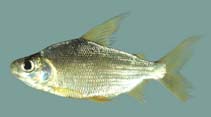| Family: |
Curimatidae (Toothless characins) |
| Max. size: |
23 cm SL (male/unsexed) |
| Environment: |
benthopelagic; freshwater; pH range: 6 - 7.80000019073486; dH range: 25, potamodromous |
| Distribution: |
South America: Orinoco River delta, Atlantic drainages of the Guianas, lower Amazon and Tocantins rivers. |
| Diagnosis: |
|
| Biology: |
Inhabits swamps and feeds on organic debris, benthic organisms and periphyton. Has filaments on its palette which play a gustatory role and also functions in mucus secretion which facilitates ingestion of food. Appears to undergo mass migration during reproduction (Ref. 12225). During reproduction, it is then easily captured with nets along the banks where the dense vegetation is flooded (Ref. 27188). |
| IUCN Red List Status: |
Not Evaluated (N.E.) Ref. (130435)
|
| Threat to humans: |
harmless |
| Country info: |
|
Source and more info: www.fishbase.org. For personal, classroom, and other internal use only. Not for publication.

